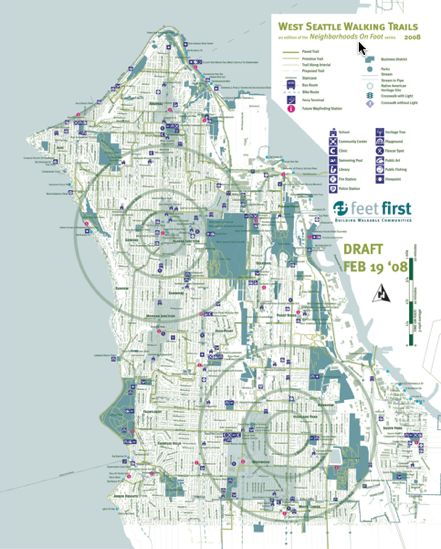
That’s a new map that could change your life, for the better: the draft of the first-ever West Seattle Walking Trails map, whose creators want to hear your take on it, before they draft the final version. (Click the image above, or this link, to download the whole thing as a PDF so you can zoom in to your neighborhood, your favorite walking route, or just to get a closer look at all of it.) One of the project ringleaders is the tireless West Seattle activist Chas Redmond, who explains what it is and how you can help with it:
Feet First, in partnership with Morgan Community Association, Delridge Neighborhoods Development Association, the Southwest and Delridge District Councils, The Southwest Historical Society, every community association here in WS and other organizations such as the West Seattle Junction Association and West Seattle Chamber of Commerce, present the first draft of the now-Climate Action Now program grant-funded walking trails map.
This is the first public review – folks should examine it, suggest changes – both additive and subtractive. There will be a second draft based on the comments of the first draft. SDOT will have the final review and there will probably be some changes from that resulting in a – final – third draft.
In the meantime, the back side of the map – which will include write-ups on every neighborhood and organization and signature interest point – will hit the streets. Probably two weeks from now we’ll have the text draft, which will coincide with the closing of comments for the first draft. The back side review will also include a second review round.
Folks should comment not only on the trails, the evolution of which can be learned by reading the contents of westseattlewalks.org, but also on the use of symbols, the correct location of schools and parks (we’ve checked, always helps to triple check), the color scheme (we’re limited to two colors to get max number of copies), and anything else.
Within a month or so we’ll have 20,000 copies of this map, which will be folded to a size about like a Metro route schedule. We have a complex and involved distribution scheme which should allow everyone in WS to at least have access to a copy. Eventually we’ll reprint in larger numbers, but want this first version to not only serve the neighborhood, but serve as a learning tool for what an urban wayfinding system and info tools about such a system might be like and how they might be better. A year of using this map will teach all of us – including the users – a whole new dimension in getting around – we hope, anyway.
Here’s the link again to take a close-up look at the map as a PDF (using zoom if you choose). As Chas mentioned, there’s a lot of backstory on the parent site for that link, westseattlewalks.org – once you’ve reviewed the map, Chas asks that comments be sent to him (credmond@mac.com) and Feet First’s Seth Schromen-Wawrin (seth@feetfirst.info).

| 26 COMMENTS